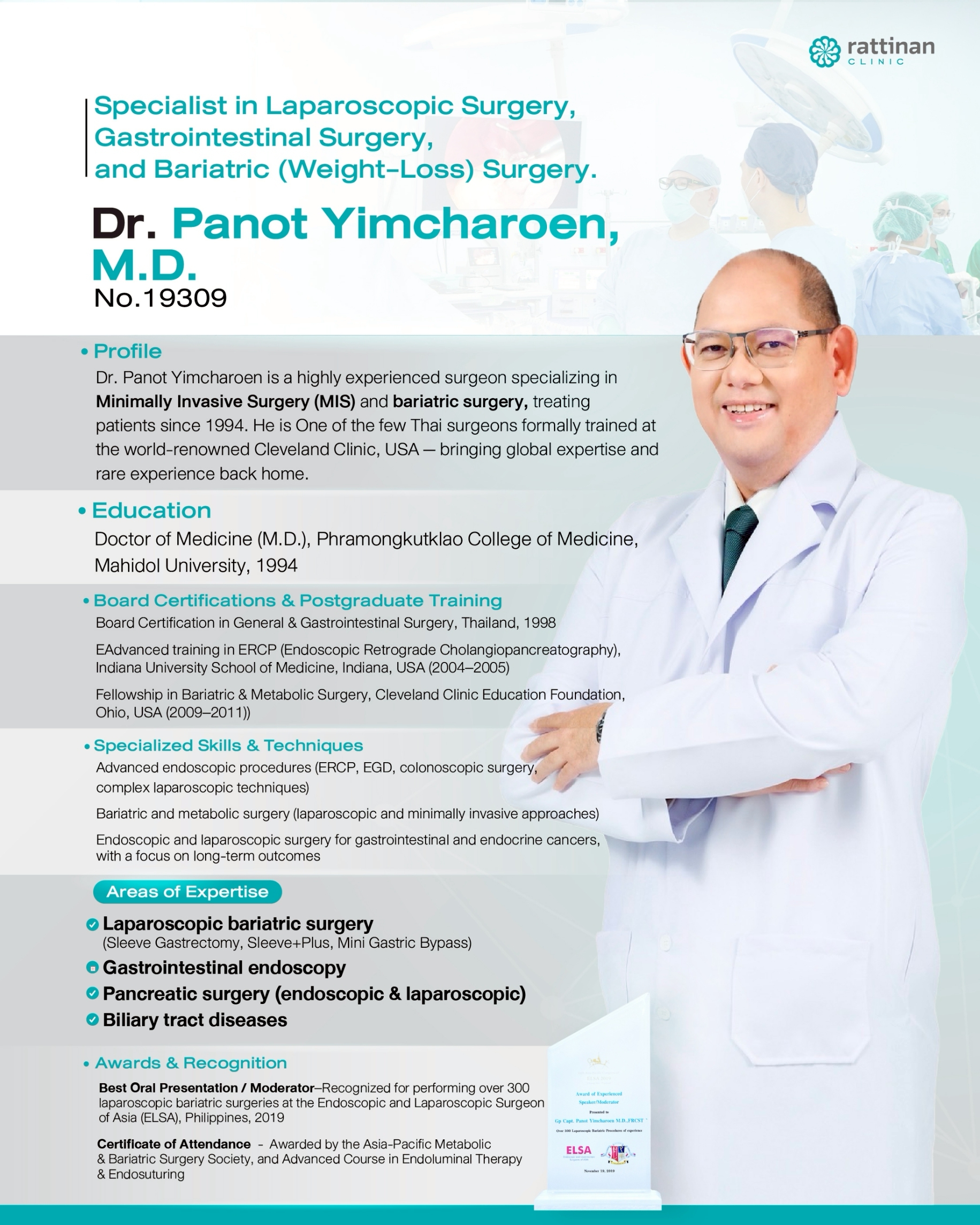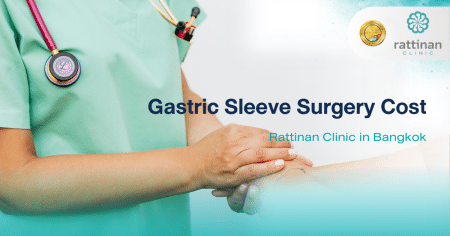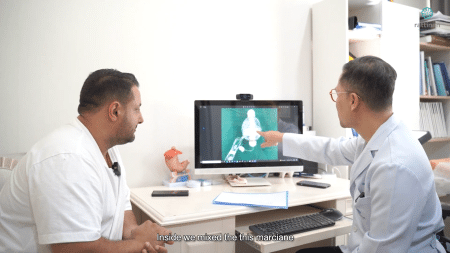What is Bariatric Surgery?
Bariatric surgery involves reducing the size of the stomach to modify the structure and pathway of digestion and nutrient absorption in the small intestine. The primary goal is to help reduce food intake, decrease appetite, and control calorie absorption into the body.
This surgical option is designed for individuals who have been unable to achieve weight loss through conventional methods such as dietary control and exercise. Additionally, bariatric surgery can help reduce the risk of obesity-related conditions, including diabetes and high blood pressure.
It’s important to note that this procedure represents a significant medical intervention that requires careful consideration and consultation with qualified healthcare professionals to determine if it’s the most appropriate treatment option for each individual’s specific circumstances.
Which Type of Bariatric Surgery is Right for Whom?
The choice of bariatric surgery depends on several individual factors that should be carefully evaluated by medical professionals. Different surgical approaches are designed to address varying degrees of obesity and specific health conditions.
Generally, bariatric surgery may be considered appropriate for individuals who meet certain medical criteria, such as those with a significantly elevated body mass index who have not achieved sustainable weight loss through conventional methods like diet modification and regular exercise over an extended period.
The selection of a specific surgical technique depends on factors including the patient’s overall health status, existing medical conditions, lifestyle considerations, and individual weight loss goals. Some procedures focus primarily on restricting stomach capacity, while others involve both restriction and modification of nutrient absorption pathways.
It’s essential to understand that this decision requires comprehensive medical evaluation and consultation with experienced bariatric surgeons who can assess each person’s unique circumstances. The most suitable approach varies from person to person, and what works well for one individual may not be the optimal choice for another.
A thorough discussion with healthcare professionals will help determine the most appropriate surgical option, if any, based on individual medical history and specific needs.
Types of Bariatric Surgery
There are several types of bariatric surgery, each with distinct approaches and mechanisms for achieving weight loss. The main categories include:
Restrictive Procedures
These surgeries work by reducing the size of the stomach, limiting the amount of food that can be consumed at one time. The smaller stomach capacity helps patients feel full more quickly with smaller portions.
Malabsorptive Procedures
These techniques alter the digestive tract to reduce the body’s ability to absorb calories and nutrients from food, creating a bypass in the normal digestive process.
Combined Procedures
Some surgical approaches incorporate both restrictive and malabsorptive elements, working through multiple mechanisms to promote weight loss.
Each type of surgery has different success rates, potential benefits, and associated considerations. The complexity and invasiveness of these procedures also vary significantly.
It’s worth noting that the field of bariatric surgery continues to evolve, with ongoing research leading to refinements in existing techniques and development of newer approaches. The selection of the most appropriate procedure requires careful evaluation by qualified surgeons who can assess individual patient factors.
A comprehensive consultation with experienced medical professionals is essential to understand which specific surgical option, if any, might be most suitable for each person’s unique medical situation and weight loss goals.
5 Types of Bariatric Surgery at Rattinan Clinic Thailand
At Rattinan Clinic, we offer 5 different types of bariatric surgery, each designed to meet varying patient needs and medical circumstances. These procedures range from those that primarily restrict food intake to others that modify the digestive process, allowing our medical team to recommend the most appropriate surgical approach based on individual health status, weight loss goals, and medical history. Through comprehensive evaluation and detailed consultation, our experienced surgical team works with each patient to select the optimal procedure from these available options, ensuring personalized care and the best possible outcomes for their specific situation.
Endoscopic Gastric Balloon – Safe Weight Loss Without Surgery
An endoscopic gastric balloon is a non-surgical weight loss procedure where a deflated balloon is placed into your stomach through your mouth using a thin, flexible camera called an endoscope. Once positioned, the balloon is filled with saline solution to expand it. The inflated balloon takes up space in your stomach, helping you feel full sooner, eat smaller portions, and lose weight. When the treatment period ends, the balloon is removed using the same endoscopic approach.
Who Might Be a Good Candidate
- Individuals with a BMI of 27 or higher
- Those who have tried natural weight loss methods without lasting success
- People who are not suitable candidates for weight loss surgery or prefer to avoid surgical procedures
- Individuals with weight-related health conditions such as diabetes or high blood pressure
- Those who need to lose weight before major surgery
Potential Benefits
- Non-surgical approach – no incisions or cuts required
- Reversible procedure – the balloon can be removed when treatment is complete, and your stomach returns to its normal size
- Lower risk profile – generally safer than surgical weight loss procedures
- Measurable results – patients may lose 10-25% of their starting weight
- Quick procedure – placement typically takes only 20-30 minutes
- Behavioral support – helps you adapt to eating smaller portions
- No external scarring – leaves no visible marks on your body
Important Considerations and Limitations
- Temporary solution – weight may return after balloon removal without sustained lifestyle changes
- Initial adjustment period – nausea, vomiting, and stomach discomfort are common for 3-7 days
- Not suitable for everyone – patients with severe stomach conditions like ulcers cannot undergo this procedure
- Requires commitment – you’ll still need to maintain dietary control and exercise for optimal results
- Limited duration – the balloon can only remain in place for 6-12 months before removal is necessary
- Cost considerations – may be more expensive than traditional diet and exercise approaches
Recovery and Timeline
- Day one – brief hospital observation for 1-2 hours, then you can typically go home the same day
- First week – you may experience nausea, vomiting, and stomach discomfort; liquid diet is usually recommended
- Weeks 2-4 – gradual introduction of soft foods as side effects diminish
- Month 2 onward – return to regular foods, though in much smaller quantities than before
- Return to work – most people can resume work within 1-3 days
- Exercise – light activity like walking can begin after the first week
Follow-up Care Regular appointments with your healthcare team every 1-3 months are essential to monitor your progress, provide nutritional guidance, support your exercise routine, and prepare for balloon removal when the treatment period concludes.
The gastric balloon can be an effective option for people seeking safe weight loss without surgery. However, long-term success depends on your commitment to developing healthier eating habits and lifestyle changes that you can maintain after the balloon is removed.
OverStitch Gastric Plication – No Scars Weight Loss
OverStitch is a weight loss procedure that makes your stomach smaller using a special camera through your mouth. No cuts are made on your belly, so there are no scars. You recover quickly and can get back to normal life fast while losing weight effectively.
Who Is This For?
- People with BMI 27.5 or higher
- Those who tried diet and exercise but couldn’t lose weight
- Anyone who wants to avoid surgery with cuts
- People with diabetes or high blood pressure from being overweight
- Those who need to get back to work quickly
- People who had gastric balloon before and want something longer-lasting
- Ages 18-65 with good overall health
Why Choose OverStitch?
- No scars – everything is done through your mouth
- Go home quickly – same day or stay one night
- Very safe – much safer than regular surgery
- Lose 15-25% of your current weight
- Feel healthier – better diabetes and blood pressure control
- Back to work fast – in just 2-3 days
- No special vitamins needed – your body absorbs food normally
- Can be adjusted later if needed
Things to Know
- You must control what you eat or your stomach might stretch back
- Results depend on how well you follow the plan
- May not work for people who are very overweight (BMI over 40)
- You need to eat slowly and chew well
- Small chance of infection (very rare)
- Costs more than non-surgical options
- Need regular check-ups with your doctor
What to Expect After Treatment
Day 1
- Stay in hospital for observation
- Drink only clear liquids
- Might feel a little sick but much less than regular surgery
- Can walk around after a few hours
Week 1
- Eat liquids and very soft foods (soup, porridge)
- No solid food or fizzy drinks
- Can go back to work in 2-3 days
Weeks 2-4
- Start eating soft foods and mashed fruits
- Slowly add thicker foods
- Begin light walking
Month 2 and Beyond
- Eat normal food but much smaller amounts
- Must eat slowly and chew very well
- Can do all types of exercise
Regular Check-ups
- Visit doctor at 1, 3, and 6 months
- Yearly camera check to see how everything looks
- Get help with eating and exercise plans
Keys to Success
- Be willing to change how you eat
- Exercise regularly
- Keep all doctor appointments
- Get support from family and friends
OverStitch is perfect for people who want safe weight loss without surgery scars, but you must be ready to change your eating habits for long-term success.
Gastric Sleeve Surgery – Permanent Weight Loss Solution
Gastric sleeve surgery removes about 80% of your stomach, leaving a small tube-shaped pouch. This makes you feel full faster and less hungry, helping you lose weight effectively and keep it off long-term.
Who Is This For?
- BMI 27.5 or higher
- Tried other weight loss methods for at least 2 years without success
- Have weight-related health problems like diabetes, high blood pressure, or sleep apnea
- Ages 18-60 and healthy enough for surgery
- Ready to change eating habits for life
- Understand the risks of surgery
Why Choose Gastric Sleeve?
- Lose 60-80% of excess weight – most effective long-term weight loss
- Feel less hungry – removes part of stomach that makes hunger hormone
- No rerouting – food goes through normal path, so you absorb nutrients properly
- Improves health conditions – better diabetes control, lower blood pressure
- Better quality of life – less joint pain, no more sleep apnea
- No foreign objects – unlike gastric bands, nothing artificial stays in your body
- Small incisions – minimally invasive surgery, faster healing
Important Things to Know
- Permanent decision – can’t put your stomach back once it’s removed
- Surgery risks – infection, bleeding, or leaking (rare but serious)
- Need vitamins for life – especially B12, iron, and calcium
- May throw up if you eat too much or too fast
- Possible acid reflux – some people develop heartburn
- Loose skin from rapid weight loss
- Expensive – usually not covered by insurance
- Lifestyle change required – must change how you eat and exercise forever
What to Expect After Surgery
Week 1
- Stay in hospital 2-3 days
- Clear liquids only at first
- Gradually add thin liquids like broth and low-fat milk
- Some pain at incision sites (manageable with medication)
Weeks 2-4
- Thick liquids and pureed foods like porridge, mashed fruit, yogurt
- Start light walking at home
- Return to work in 2-3 weeks (desk jobs)
Months 2-3
- Soft foods like cooked eggs, steamed fish, soft vegetables
- Increase exercise like brisk walking or swimming
- Weight loss happens quickly during this time
Months 4-6
- Regular foods but very small portions (1/4 of what you used to eat)
- Can do more intense exercise like yoga or gym workouts
- Continue steady weight loss
Year 1 and Beyond
- Weight loss slows but continues
- Eat all food groups in small amounts
- Exercise at least 150 minutes per week
- Maintain new lifestyle habits
Regular Check-ups
- Months 1, 3, 6, 12: Blood tests and health checks
- Every year: Check vitamin and mineral levels
- Ongoing support: Nutritionist, psychologist, fitness guidance
Keys to Success
- Follow all doctor’s instructions exactly
- Eat slowly and chew food thoroughly
- Exercise regularly
- Get support from family and friends
- Keep all follow-up appointments
Gastric sleeve is the most effective long-term weight loss surgery for people with severe obesity who are ready to make permanent lifestyle changes. It requires careful consideration and preparation, but offers excellent results for the right candidates.
Gastric Bypass Surgery – Maximum Weight Loss with Rerouting
Gastric bypass surgery makes your stomach smaller AND changes the path food travels through your body. This means you eat less and absorb fewer calories. It’s the most effective option for people with severe obesity and health problems like diabetes.
Who Is This For?
- BMI 27.5 or higher
- Want better results than gastric sleeve alone
- Have type 2 diabetes and want the highest chance of remission
- Had gastric sleeve before but weight came back or results weren’t good enough
- Have severe acid reflux along with obesity
- Want a procedure that’s less complex than full gastric bypass but more effective than sleeve
- Ages 18-65 and ready to follow long-term guidelines
- Want a procedure that can be reversed if needed
Why Choose Gastric Bypass?
- Best weight loss – lose 70-85% of excess weight (more than sleeve)
- Easier surgery – takes less time and has lower risk than full gastric bypass
- Cures diabetes – 70-80% chance of diabetes remission
- Fixes acid reflux – works better than sleeve for heartburn
- Can be reversed – easier to fix problems or reverse than full bypass
- Keeps your stomach – stomach is blocked, not removed, so it can be used again later
- Better medication absorption – drugs still absorb well because not all small intestine is bypassed
- Less dumping syndrome – fewer episodes of nausea/diarrhea after eating sugar
- Long-term results – keeps weight off better than sleeve over time
Important Things to Know
- Newer technique – less long-term data compared to traditional methods
- Surgery risks – higher than sleeve because intestines are reconnected
- Need vitamins for life – though less than full bypass
- Bile reflux risk – bile acid can sometimes flow back to stomach
- Leak risk – small chance of intestinal connection leaking
- More expensive – costs more than sleeve due to complexity
- Must change eating habits – eat slowly, chew well, avoid certain foods
- Regular monitoring needed – check for side effects and effectiveness
What to Expect After Surgery
Week 1
- Stay in hospital 2-4 days to watch intestinal connections heal
- Clear liquids only for first 1-2 days
- Gradually add thin liquids like broth, protein shakes, low-fat milk
- May have more pain than sleeve due to intestinal connections
Weeks 2-4
- Thick liquids and pureed foods like porridge, mashed fruit, yogurt
- Start gentle walking as recommended
- Return to work in 2-3 weeks (desk jobs)
- Begin taking vitamins and minerals as prescribed
Months 2-3
- Start soft foods, focusing on protein like eggs, fish, tender meat
- Avoid high-fat and high-sugar foods
- Increase exercise like brisk walking or swimming
- Rapid weight loss during this period
Months 4-6
- Regular foods but very small portions (1/6 of original amount)
- Must eat slowly, chew thoroughly, and separate liquids from meals
- Can do more intense exercise based on ability
Year 1 and Beyond
- Weight continues dropping for 12-18 months
- Regular health monitoring for complications
- Better long-term weight maintenance than sleeve
Regular Check-ups
- Months 1, 3, 6, 12 – health checks and results evaluation
- Every 6 months – check vitamin B12, D, iron, calcium levels
- Every year – test liver, kidney, and bone function
- Endoscopy if needed – for acid reflux or stomach pain
Special Warnings
- Watch for bile reflux – severe stomach pain, nausea, yellow vomiting
- Eat slowly – chew thoroughly to prevent blockages
- Avoid hard-to-digest foods – tough meat, high-fiber fruits
- Drink water separately – not with meals to prevent stomach stretching
Required Vitamins
- Multivitamin 1-2 tablets daily
- Vitamin B12
- Calcium and Vitamin D
- Iron (for women of childbearing age)
Bottom Line
Mini gastric bypass offers better results than sleeve with lower risk than full bypass. It’s ideal for people wanting maximum effectiveness with the option to reverse if needed. Requires consultation with specialist surgeons to fully understand benefits and risks before deciding.
Mini Gastric Bypass Surgery – Advanced Weight Loss Technique
Mini gastric bypass is a newer technique that builds on gastric sleeve surgery by adding a small rerouting of food through your intestines. This makes weight loss even more effective and long-lasting, perfect for people who want maximum results.
Who Is This For?
- BMI 27.5 or higher
- Want better results than gastric sleeve alone
- Have type 2 diabetes and want the best chance of getting rid of it
- Had gastric sleeve before but weight came back or didn’t work well enough
- Have severe heartburn along with obesity
- Want a procedure that’s simpler than full gastric bypass but more effective than sleeve
- Ages 18-65 and ready to follow long-term guidelines
- Want a procedure that can be reversed if problems occur
Why Choose Mini Gastric Bypass?
- Better weight loss – lose 70-85% of excess weight (more than sleeve)
- Simpler surgery – takes less time and safer than full gastric bypass
- Cures diabetes – 70-80% chance of completely getting rid of type 2 diabetes
- Fixes heartburn – works much better than sleeve for acid reflux
- Can be undone – easier to reverse or fix problems than full bypass
- Keeps your stomach – stomach is blocked, not removed, so it can work again later
- Medications work better – drugs still absorb well since not all small intestine is bypassed
- Less dumping syndrome – fewer episodes of feeling sick after eating sugar
- Keeps weight off longer – better long-term results than sleeve
Important Things to Know
- Newer technique – less long-term research compared to older methods
- Surgery risks – higher than sleeve because intestines are reconnected
- Need vitamins for life – though fewer than full bypass
- Bile reflux risk – bile can sometimes flow back to stomach causing pain
- Connection leak risk – small chance of intestinal connection problems
- More expensive – costs more than sleeve due to complexity
- Must change eating habits – eat slowly, chew well, avoid certain foods
- Regular check-ups needed – monitor for side effects and results
What to Expect After Surgery
Week 1
- Stay in hospital 2-4 days to make sure intestinal connections heal properly
- Clear liquids only for first 1-2 days
- Gradually add thin liquids like broth, protein shakes, low-fat milk
- May have slightly more pain than sleeve due to intestinal work
Weeks 2-4
- Thick liquids and pureed foods like porridge, mashed fruit, yogurt
- Start gentle walking as recommended
- Return to work in 2-3 weeks (office jobs)
- Begin taking prescribed vitamins and minerals
Months 2-3
- Start soft foods, focusing mainly on protein like eggs, fish, tender meat
- Avoid high-fat and high-sugar foods
- Increase exercise like brisk walking or swimming
- Very rapid weight loss during this time
Months 4-6
- Regular foods but tiny portions (1/6 of what you used to eat)
- Must eat slowly, chew thoroughly, and drink water separately from meals
- Can do more intense exercise based on your ability
Year 1 and Beyond
- Weight keeps dropping for 12-18 months
- Regular health monitoring for any complications
- Better long-term weight maintenance than sleeve alone
Regular Check-ups
- Months 1, 3, 6, 12 – health checks and progress evaluation
- Every 6 months – check vitamin B12, D, iron, calcium levels
- Every year – test liver, kidney, and bone function
- Camera test if needed – for acid reflux or stomach pain
Special Things to Watch For
- Bile reflux symptoms – severe stomach pain, nausea, yellow vomiting
- Eat very slowly – chew thoroughly to prevent food blockages
- Avoid hard foods – tough meat, high-fiber fruits that are hard to digest
- Drink water separately – not with meals to prevent stomach stretching
Required Vitamins for Life
- Multivitamin 1-2 tablets daily
- Vitamin B12
- Calcium and Vitamin D
- Iron (especially for women)
Bottom Line
Mini gastric bypass gives you better results than sleeve with lower risk than full bypass. It’s perfect for people wanting maximum effectiveness with the option to reverse if needed. You must talk to specialist surgeons to fully understand all benefits and risks before deciding.
Dr. Panot Yimcharoen
Surgeon Laparoscopic Weight Loss Surgery

Dr. Panot Yimcharoen is a surgeon specializing in minimally invasive surgery (MIS) and weight loss surgery. He has been providing medical care since 1994 and has furthered his education in several countries, including the United States and Canada.
Board Certifications and Advanced Training
- Board Certification in General Surgery, Royal College of Surgeons of Thailand, 1998
- ERCP (Endoscopic Retrograde Cholangiopancreatography), Indiana University School of Medicine, Indiana, USA, 2004-2005
- Bariatric and Metabolic Surgery, Cleveland Clinic Education Foundation, Ohio, USA, 2009-2011








